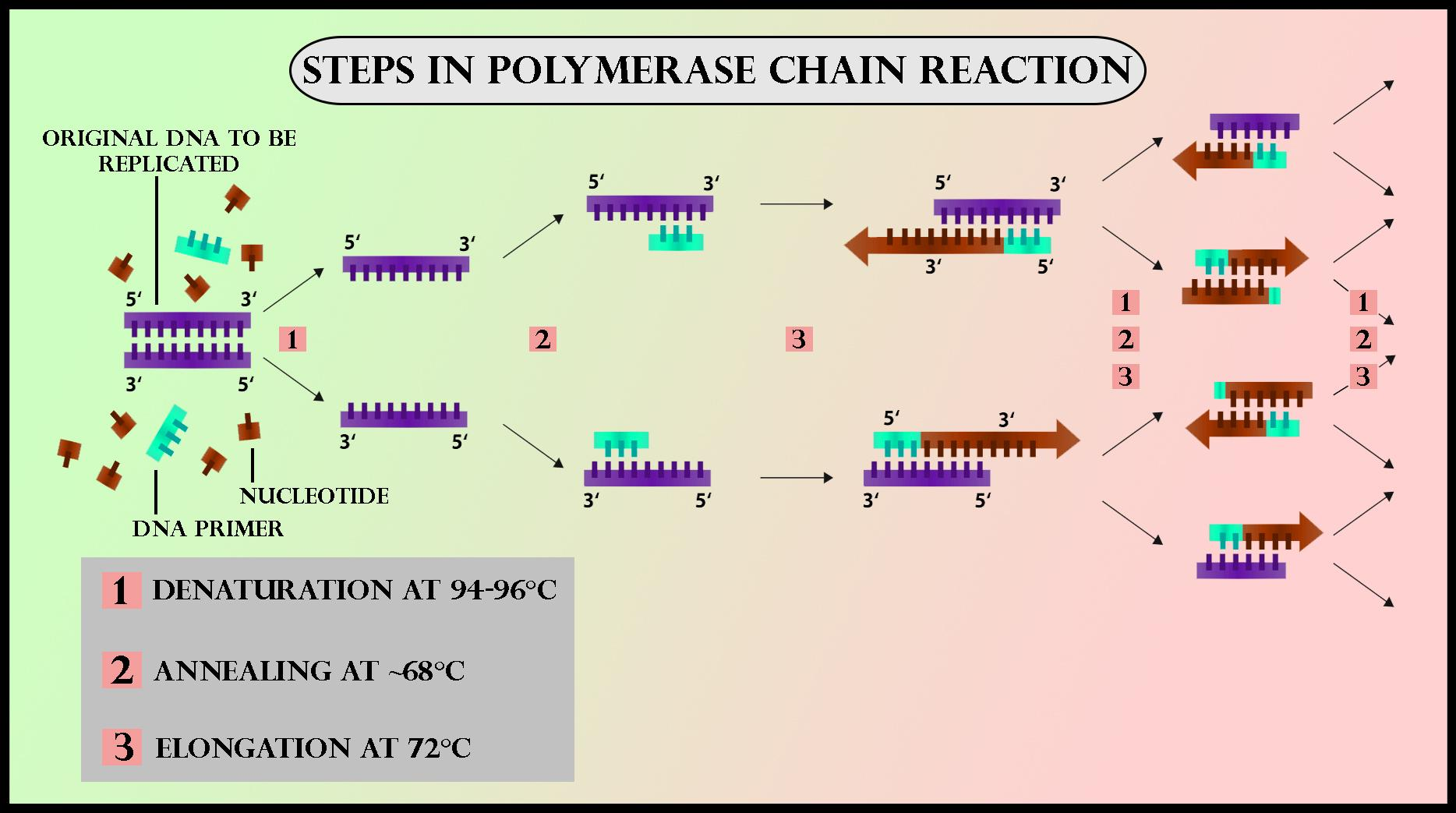
Draw a neat labelled diagram showing steps of PCR?
Answer
576.3k+ views
Hint: Polymerase chain reaction, or PCR, is a technique for generating several copies of a particular region of DNA. The double stranded DNA should be transformed into single strands to make copies, and each strand can be further amplified.
Complete answer:
The PCR process includes the following steps.
Step 1: Denaturation
As with DNA replication it is important to separate the two strands in the double helix of DNA.
The separation happens by increasing the mixture temperature, allowing the hydrogen bonds to break down between the complementary DNA strands. That process is known as denaturation.
Step 2: Annealing
The primers bind to the sequences of target DNA and start polymerisation. This can only happen after the solution temperature has decreased. To each strand one primer gets bonded.
Step 3: Extension
New DNA strands are built using the initial strands as templates. An enzyme with DNA polymerase binds together free nucleotides of DNA. This enzyme is also Taq polymerase, an enzyme that was originally isolated from Thermus aquaticus, a thermophilic bacterium. The order in which the free nucleotides are inserted is determined by the nucleotide sequence at the original DNA strand (template).
The outcome of one PCR loop is two double-stranded target DNA sequences, each of which comprises one newly formed strand and one initial strand.
The cycle is repeated several times (usually 20–30), because the majority of processes using PCR involve large amounts of DNA. Having one billion or so copies takes only 2-3 hours.

Additional Information:
The US biochemist Kary Mullis initially invented the polymerase chain reaction ( PCR) in 1983. In 1993 he received the Nobel Prize in Chemistry for his pioneering work. We need 5 key ingredients to perform a PCR. They are the copyable DNA template, primers, DNA nucleotide bases, Taq polymerase enzyme, and buffer.
Note: PCR's purpose is usually to make enough of the target DNA region that it can be analysed or otherwise used. For example, for further studies, DNA amplified by PCR may be sent for sequencing, visualised by gel electrophoresis or cloned into a plasmid. PCR has many practical applications and a lot of testing. It is used regularly in DNA cloning, medical diagnosis and DNA forensic analysis.
Complete answer:
The PCR process includes the following steps.
Step 1: Denaturation
As with DNA replication it is important to separate the two strands in the double helix of DNA.
The separation happens by increasing the mixture temperature, allowing the hydrogen bonds to break down between the complementary DNA strands. That process is known as denaturation.
Step 2: Annealing
The primers bind to the sequences of target DNA and start polymerisation. This can only happen after the solution temperature has decreased. To each strand one primer gets bonded.
Step 3: Extension
New DNA strands are built using the initial strands as templates. An enzyme with DNA polymerase binds together free nucleotides of DNA. This enzyme is also Taq polymerase, an enzyme that was originally isolated from Thermus aquaticus, a thermophilic bacterium. The order in which the free nucleotides are inserted is determined by the nucleotide sequence at the original DNA strand (template).
The outcome of one PCR loop is two double-stranded target DNA sequences, each of which comprises one newly formed strand and one initial strand.
The cycle is repeated several times (usually 20–30), because the majority of processes using PCR involve large amounts of DNA. Having one billion or so copies takes only 2-3 hours.

Additional Information:
The US biochemist Kary Mullis initially invented the polymerase chain reaction ( PCR) in 1983. In 1993 he received the Nobel Prize in Chemistry for his pioneering work. We need 5 key ingredients to perform a PCR. They are the copyable DNA template, primers, DNA nucleotide bases, Taq polymerase enzyme, and buffer.
Note: PCR's purpose is usually to make enough of the target DNA region that it can be analysed or otherwise used. For example, for further studies, DNA amplified by PCR may be sent for sequencing, visualised by gel electrophoresis or cloned into a plasmid. PCR has many practical applications and a lot of testing. It is used regularly in DNA cloning, medical diagnosis and DNA forensic analysis.
Recently Updated Pages
A man running at a speed 5 ms is viewed in the side class 12 physics CBSE

The number of solutions in x in 02pi for which sqrt class 12 maths CBSE

State and explain Hardy Weinbergs Principle class 12 biology CBSE

Write any two methods of preparation of phenol Give class 12 chemistry CBSE

Which of the following statements is wrong a Amnion class 12 biology CBSE

Differentiate between action potential and resting class 12 biology CBSE

Trending doubts
What are the major means of transport Explain each class 12 social science CBSE

Which are the Top 10 Largest Countries of the World?

Draw a labelled sketch of the human eye class 12 physics CBSE

Explain sex determination in humans with line diag class 12 biology CBSE

Explain sex determination in humans with the help of class 12 biology CBSE

Differentiate between homogeneous and heterogeneous class 12 chemistry CBSE




